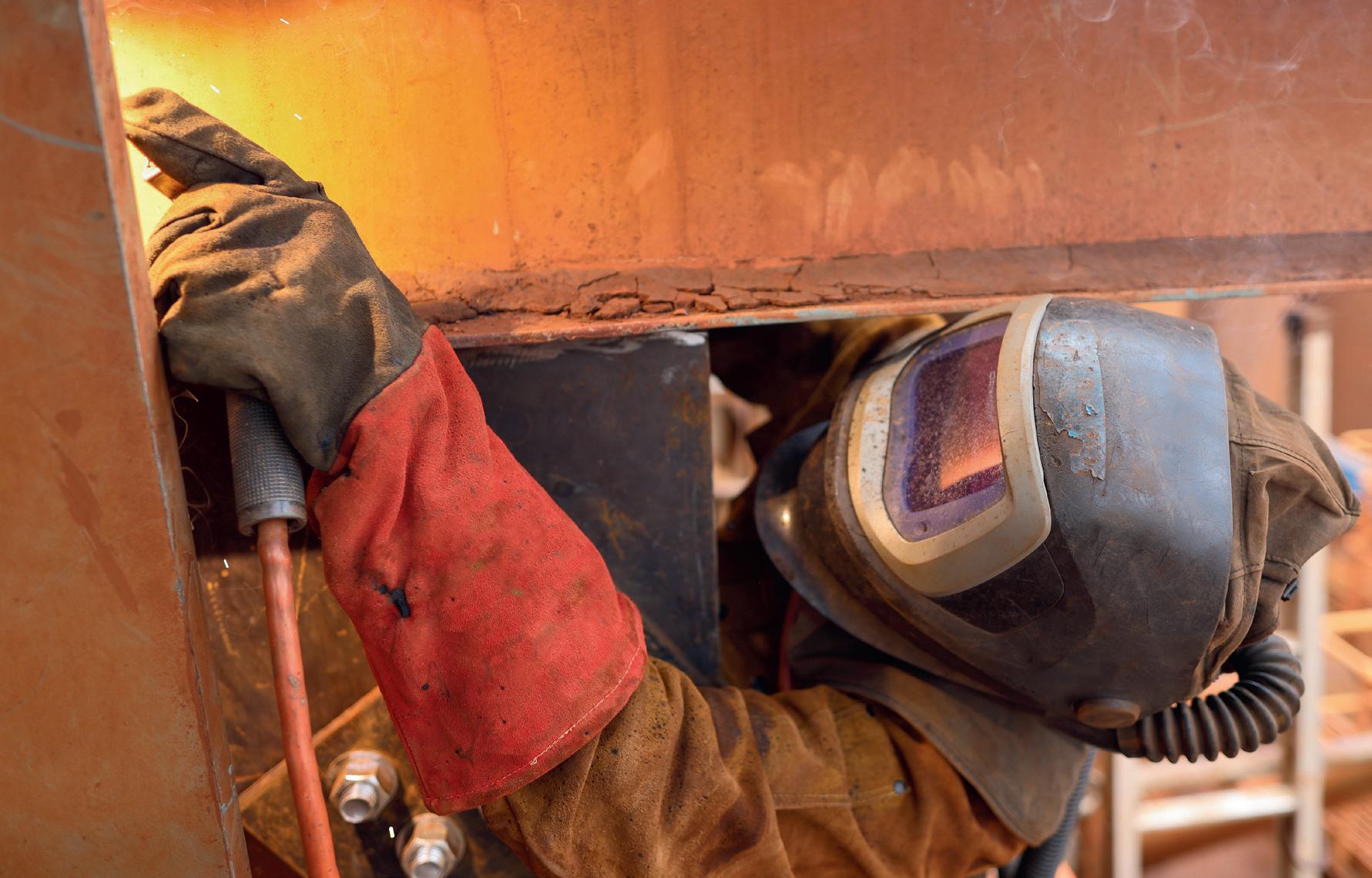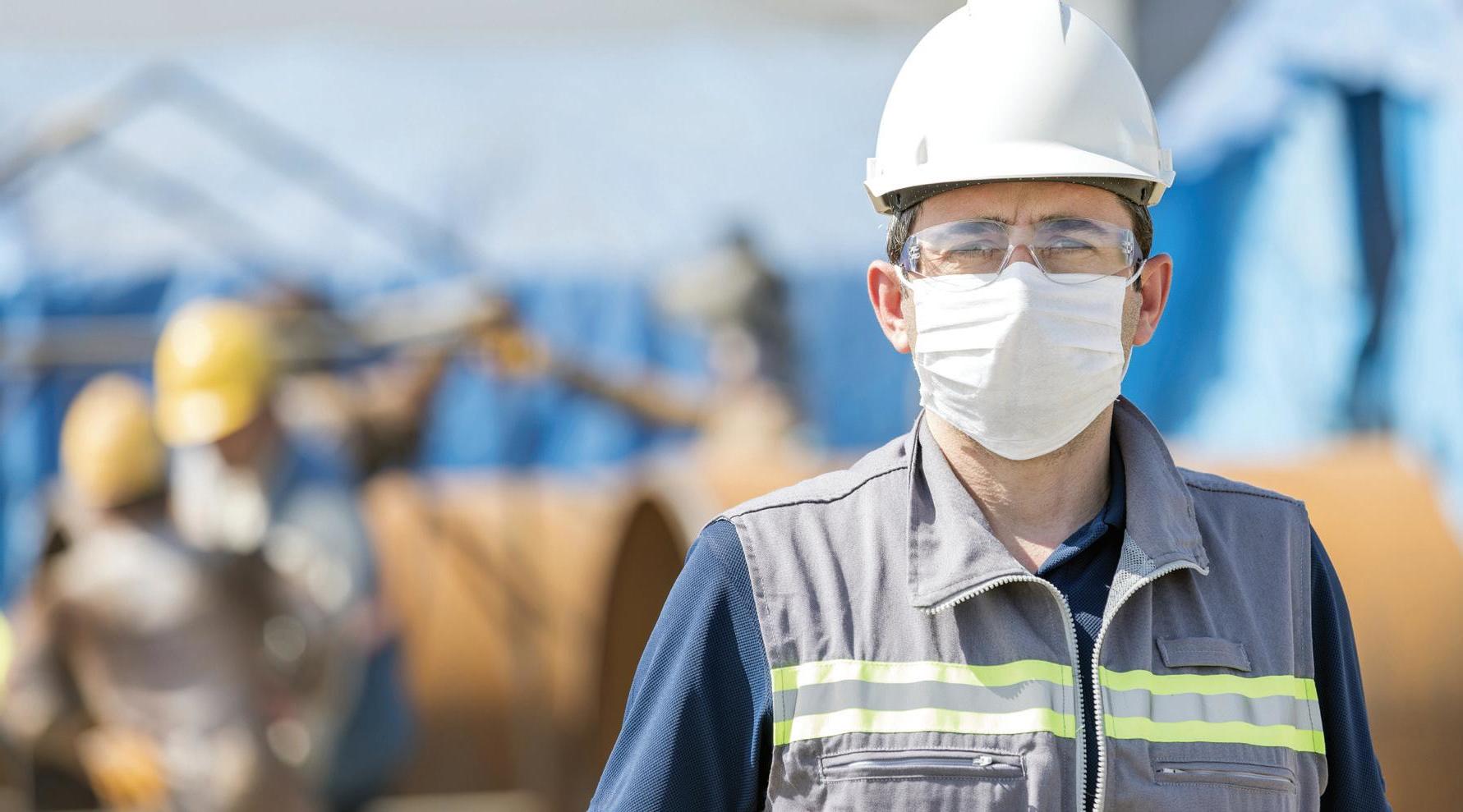
6 minute read
Welder respiratory PPE — control measures and responsibilities
WELDER RESPIRATORY PPE
CONTROL MEASURES AND RESPONSIBILITIES
©stock.adobe.com/au/Kings Access
Since welding fume was reclassified as “carcinogenic to humans” by the International Agency for Research on Cancer (IARC) in 2017, the severe health effects of welding fume exposure have been well documented and widely recognised. These effects range from lung function abnormalities to stomach ulcers, kidney damage and several types of cancer. Where do things currently stand, what control measures should be taken and who is responsible for ensuring workers are protected?
The 2017 IARC reclassification increased awareness of the dangers of welding fume and is an important step in the right direction for the industry at large; however, it means little without proper action being taken. Recognising the health risks associated with welding fume exposure should encourage all employers of welders to review their risk assessments and revise their control measures. As such, there is a critical need to give workplaces clear and practical advice that can help to keep workers protected. Following such guidance can make staying safe straightforward, no matter how serious the risk.
What control measures should be taken?
In relation to the hierarchy of controls, personal protective equipment (PPE) is often referred to as the last resort. However, this is not tenable when it comes to welding, where suitable PPE must always be worn. In fact, the established consensus is that a combination of local exhaust ventilation (LEV) and respiratory PPE is the most practical and effective ‘product control’ method against welding fume for all workers in welding environments.
On the one hand, properly located LEV can capture welding fume directly at its source, which can not only protect the welder, but also all workers in close proximity to the welder. On the other hand, PPE for respiratory protection from welding fume is commonly available in two main forms: welding helmets with integrated respiratory protection and half mask respirators. According to the ‘2020 Welding fume and respiratory protection survey’ from AWS, welding helmets with integrated powered air purifying respirators (PAPR) are the most widely used form of respiratory protection among welders in Australia and New Zealand. These are also mandatory within many businesses.
They have a required minimum protection factor (RMPF) of 50, meaning they supply a minimum 50 times cleaner air than the welder would otherwise be breathing unprotected. Simultaneously, the helmet itself protects the welder’s eyes and face from radiation and high-velocity particles. Built-in hard hats (safety helmets) and earmuffs are also available with certain PAPR systems, and this amounts to five possible levels of integrated welding protection (eye, face, respiratory, head, hearing).
Conversely, a disposable or reusable halfmask respirator can be worn underneath a welding helmet to provide an RMPF of 10 (ie, 10 times cleaner air than you would otherwise breathe unprotected). To ensure this level of protection, the welder must be fit tested (annually is recommended) and clean shaven to maintain an effective negative pressure seal. When compared to disposable and reusable half-face mask respiratory protection, then, PAPR systems provide superior respiratory protection (in the form of five times cleaner air) and enhanced comfort without the need for fit testing or a clean-shaven condition.
Put simply, the primary responsibility to ensure that workers are protected lies with their employer. This is reflected under both the Australian Work, Health and Safety Laws and the New Zealand Health and Safety at Work Regulations, which each list employers as financially responsible for providing PPE to workers. Moreover, when selecting PPE, the employer should consult with their workers, where reasonable. After all, given they are directly affected by the hazards, welders are entitled and well qualified to contribute to the decision-making process.
Thanks to court cases and research, the world has shifted to more of a health and safety focus. It’s now up to companies to update their approach to welding fume and welders’ protection.
HOW TO ACHIEVE ISO ACCREDITATION SUCCESS — EVEN DURING COVID-19

©stock.adobe.com/au/Funtay
COVID-19 has had severe impacts on the Australian construction industry, but AJ Grant Group, a respected residential and commercial building company, was determined to push on with their certifi cation effort regardless of the pandemic’s pressures.
The safety experts at Recovery Partners helped to AJ Grant Group achieve the trifecta: triple certifi cation for their Integrated Management System (IMS), including ISO14001 Environmental Management, ISO45001 Safety Management Systems and ISO9001 Quality Management.
Why AJ Grant Group wanted ISO Accreditation
“ISO Accreditation was the formalised stamp of approval we needed,” says CEO Brad Honeyman.
“The ISO Accreditation achieves several things,” he continues.
“It demonstrates the level of commitment from management and the whole business to keeping everyone safe. It allows us to lead by example, ensuring that our teams are safety conscious and actively prioritising safety, and it gives us a distinct competitive advantage when tendering for major contracts against other companies that are not certifi ed.”
Certifi cation preparation
To achieve the certification, Recovery Partners guided the AJ Grant Group team through an extensive IMS development process over several months.
You can’t buy a product off the shelf for an IMS. It has to be customised and it has to be excellent. While the IMS is being developed, it’s also being implemented. Once the safety policies and processes are developed, the IMS needs to be trialled and introduced to key stakeholders. They give feedback and Recovery Partners continuously fi ne-tune it. At the same time, Recovery Partners gather evidence that the audit team requires.
Sustainable Accreditation
When everyone was satisfi ed with the IMS, it was time to contact the accrediting body, Sustainable Accreditation.
“Sustainable provided a Lead Auditor and Recovery Partners project-managed, coordinating with them and with our internal team,” Brad explains.
While the auditing process would typically involve a lot of site visits to verify that subcontractors and AJ Grant Group team members were adhering to the safe processes and practices of the IMS, COVID-19 made this impossible.
So, Sustainable relied more on spot checks over the phone, where they would call and interview site supervisors or ask for certain documentation to be provided within the next half-hour.
“AJ Grant Group has a lot of tradespeople as subcontractors,” Recovery Partners says.
“Therefore, an integral part of the audit was checking that this labour force meets the standard it needs to. To guarantee the quality of the workmanship and end product for the client, the subcontractors have to meet the criteria for performance and safety systems.”
Benefi ts of accreditation
Benefi ts of ISO accreditation include: • Enhance workplace safety • Reduce costs and lower insurance premiums • Increase revenue and Return On Investment (ROI) • Enhance company image and provide competitive edge • Improve productivity
Return On Investment
Brad says the AJ Grant Group team have already started to see ROI.
“It’s been a great morale booster for staff. When we notifi ed everyone, the feedback was fantastic. It was frustrating for everyone when we missed out on jobs or tenders due to our lack of certifi cation, because we knew we could do those projects, and do them well. We’ve got the experience. Now, there’s nothing holding us back. Our team are feeling positive and excited about the prospect of new business, and this helps them commit to our safety systems. This commitment then helps our business grow.”
Brad continues, “We worked hard on this because we knew the benefi t would be there. It’s not surprising but it’s gratifying now that we’re already seeing doors opening. There are exciting times ahead for AJ Grant Group and the future looks bright. There are many companies that can assist in WHS, but Recovery Partners help you make it happen.”
Recovery Partners operate at the forefront of safety service provision in Australia. We bring decades of combined experience and constantly evolving knowledge to our partnerships with Australian businesses. With consultants spread from coast to coast, we’re well-placed to advise and assist you with your WHS/OHS needs, wherever you are. Visit www.rrp.com.au today to learn more.

